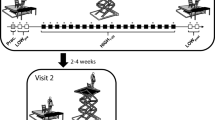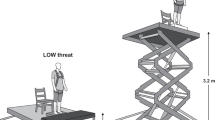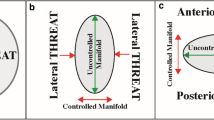Abstract
Individuals report directing attention toward and away from multiple sources when standing under height-related postural threat, and these changes in attention focus are associated with postural control modifications. As it is unknown whether these changes generalize to other types of threat situations, this study aimed to quantify changes in attention focus and examine their relationship with postural control changes in response to a direct threat to stability. Eighty young adults stood on a force plate fixed to a translating platform. Three postural threat conditions were created by altering the expectation of, and prior experience with, a postural perturbation: no threat of perturbation, threat without perturbation experience, and threat with perturbation experience. When threatened, participants were more anxious and reported directing more attention to movement processes, threat-related stimuli, and self-regulatory strategies, and less to task-irrelevant information. Postural sway amplitude and frequency increased with threat, with greater increases in frequency and smaller increases in amplitude observed with experience. Without experience, threat-related changes in postural control were accounted for by changes in anxiety; larger changes in anxiety were related to larger changes in sway amplitude. With experience, threat-related postural control changes were accounted for by changes in attention focus; increases in attention to movement processes were related to greater forward leaning and increases in sway amplitude, while increases in attention to self-regulatory strategies were related to greater increases in sway frequency. Results suggest that relationships between threat-related changes in anxiety, attention focus, and postural control depend on the context associated with the threat.




Similar content being viewed by others
References
Adkin, A. L., Frank, J. S., Carpenter, M. G., & Peysar, G. W. (2000). Postural control is scaled to level of postural threat. Gait and Posture, 12, 87–93. https://doi.org/10.1016/S0966-6362(00)00057-6
Adkin, A. L., Frank, J. S., Carpenter, M. G., & Peysar, G. W. (2002). Fear of falling modifies anticipatory postural control. Experimental Brain Research, 143, 160–170. https://doi.org/10.1007/s00221-001-0974-8
Alpers, G. W., & Adolph, D. (2008). Exposure to heights in a theme park: Fear, dizziness, and body sway. Journal of Anxiety Disorders, 22, 591–601. https://doi.org/10.1016/j.janxdis.2007.05.008
Bar-Haim, Y., Lamy, D., Pergamin, L., Bakermans-Kranenburg, M. J., & van Ijzendoorn, M. H. (2007). Threat-related attentional bias in anxious and nonanxious individuals: A meta-analytic study. Psychological Bulletin, 133, 1–24. https://doi.org/10.1037/0033-2909.133.1.1
Brown, L. A., & Frank, J. S. (1997). Postural compensations to the potential consequences of instability: Kinematics. Gait and Posture, 6, 89–97. https://doi.org/10.1016/S0966-6362(96)01106-X
Brown, L. A., Polych, M. A., & Doan, J. B. (2006). The effect of anxiety on the regulation of upright standing among younger and older adults. Gait and Posture, 24, 397–405. https://doi.org/10.1016/j.gaitpost.2005.04.013
Carpenter, M. G., Adkin, A. L., Brawley, L. R., & Frank, J. S. (2006). Postural, physiological and psychological reactions to challenging balance: Does age make a difference? Age and Ageing, 35, 298–303. https://doi.org/10.1093/ageing/afl002
Carpenter, M. G., Frank, J. S., & Silcher, C. P. (1999). Surface height effects on postural control: A hypothesis for a stiffness strategy for stance. Journal of Vestibular Research, 9, 277–286.
Carpenter, M. G., Frank, J. S., Silcher, C. P., & Peysar, G. W. (2001a). The influence of postural threat on the control of upright stance. Experimental Brain Research, 138, 210–218. https://doi.org/10.1007/s002210100681
Carpenter, M. G., Frank, J. S., Winter, D. A., & Peysar, G. W. (2001b). Sampling duration effects on centre of pressure summary measures. Gait and Posture, 13, 35–40. https://doi.org/10.1016/S0966-6362(00)00093-X
Davis, J. R., Campbell, A. D., Adkin, A. L., & Carpenter, M. G. (2009). The relationship between fear of falling and human postural control. Gait and Posture, 29, 275–279. https://doi.org/10.1016/j.gaitpost.2008.09.006
Ericsson, K. A. (2006). Protocol analysis and expert thought: Concurrent verbalizations of thinking during experts’ performance on representative tasks. The Cambridge handbook of expertise and expert (pp. 223–242)
Ericsson, K. A., & Simon, H. A. (1993). Protocol analysis. Cambridge, MA: MIT press.
Eysenck, M. W., Derakshan, N., Santos, R., & Calvo, M. G. (2007). Anxiety and cognitive performance: Attentional control theory. Emotion, 7, 336–353. https://doi.org/10.1037/1528-3542.7.2.336
Field, A. (2009). Discovering statistics using SPSS. CA: Sage Publications.
Fowles, D. C., Christie, M. J., Edelberg, R., Grings, W. W., Lykken, D. T., & Venables, P. H. (1981). Publication recommendations for electrodermal measurements. Psychophysiology, 18, 232–239. https://doi.org/10.1111/j.1469-8986.1981.tb03024.x
Green, S. B. (1991). How many subjects does it take to do a regression analysis? Multivariate Behavioral Research, 26, 499–510. https://doi.org/10.1207/s15327906mbr2603_7
Hauck, L. J., Carpenter, M. G., & Frank, J. S. (2008). Task-specific measures of balance efficacy, anxiety, and stability and their relationship to clinical balance performance. Gait and Posture, 27, 676–682. https://doi.org/10.1016/j.gaitpost.2007.09.002
Holmberg, J., Tjernstrom, F., Karlberg, M., Fransson, P. A., & Magnusson, M. (2009). Reduced postural differences between phobic postural vertigo patients and healthy subjects during a postural threat. Journal of Neurology, 256, 1258–1262. https://doi.org/10.1007/s00415-009-5110-x
Horak, F. B., Diener, H. C., & Nashner, L. M. (1989). Influence of central set on human postural responses. Journal of Neurophysiology, 62, 841–853.
Huffman, J. L., Horslen, B. C., Carpenter, M. G., & Adkin, A. L. (2009). Does increased postural threat lead to a more conscious control of posture? Gait and Posture, 30, 528–532. https://doi.org/10.1016/j.gaitpost.2009.08.001
Ishida, M., Saitoh, J., Wada, M., & Nagai, M. (2010). Effects of anticipatory anxiety and visual input on postural sway in an aversive situation. Neuroscience Letters, 474, 1–4. https://doi.org/10.1016/j.neulet.2010.02.052
Kahneman, D. (1973). Attention and effort. Englewood Cliffs, NJ: Prentice-Hall.
Maki, B. E., Holliday, P. J., & Topper, A. K. (1991). Fear of falling and postural performance in the elderly. Journal of Gerontology, 46, M123–M131. https://doi.org/10.1093/geronj/46.4.M123
Maki, B. E., Holliday, P. J., & Topper, A. K. (1994). A prospective study of postural balance and risk of falling in an ambulatory and independent elderly population. Journal of Gerontology, 49, M72–M84. https://doi.org/10.1093/geronj/49.2.M72
Maki, B. E., & Mcllroy, W. E. (1996). Influence of arousal and attention on the control of postural sway. Journal of Vestibular Research, 6, 53–59.
Maki, B. E., & Whitelaw, R. S. (1993). Influence of expectation and arousal on center-of-pressure responses to transient postural perturbations. Journal of Vestibular Research, 3, 25–39.
Masters, R., & Maxwell, J. (2008). The theory of reinvestment. International Review of Sport and Exercise Psychology, 1, 160–183. https://doi.org/10.1080/17509840802287218
Maxwell, S. E. (2000). Sample size and multiple regression analysis. Psychological Methods, 5, 434–458. https://doi.org/10.1037/1082-989X.5.4.434
McIlroy, W. E., & Maki, B. E. (1995). Adaptive changes to compensatory stepping responses. Gait and Posture, 3, 43–50. https://doi.org/10.1016/0966-6362(95)90808-6
Moore, C. M., & Egeth, H. (1998). How does feature-based attention affect visual processing? Journal of Experimental Psychology: Human Perception and Performance, 24, 1296–1310. https://doi.org/10.1037/0096-1523.24.4.1296
Nakahara, H., Takemori, S., & Tsuruoka, H. (2000). Influence of height on the spatial orientation and equilibrium of the body. Otolaryngology-Head and Neck Surgery, 123, 501–504. https://doi.org/10.1067/mhn.2000.107316
Ohno, H., Wada, M., Saitoh, J., Sunaga, N., & Nagai, M. (2004). The effect of anxiety on postural control in humans depends on visual information processing. Neuroscience Letters, 364, 37–39. https://doi.org/10.1016/j.neulet.2004.04.014
Oudejans, R. R. D., & Pijpers, J. R. (2010). Training with mild anxiety may prevent choking under higher levels of anxiety. Psychology of Sport and Exercise, 11, 44–50. https://doi.org/10.1016/j.psychsport.2009.05.002
Perna, G., Dario, A., Caldirola, D., Stefania, B., Cesarani, A., & Bellodi, L. (2001). Panic disorder: The role of the balance system. Journal of Psychiatric Research, 35, 279–286. https://doi.org/10.1016/S0022-3956(01)00031-0
Shaw, J. A., Stefanyk, L. E., Frank, J. S., Jog, M. S., & Adkin, A. L. (2012). Effects of age and pathology on stance modifications in response to increased postural threat. Gait and Posture, 35, 658–661. https://doi.org/10.1016/j.gaitpost.2011.12.020
Simeonov, P., & Hsiao, H. (2001). Height, surface firmness, and visual reference effects on balance control. Injury Prevention, 7(Suppl. I), i50–i53. https://doi.org/10.1136/ip.7.suppl_1.i50
Staab, J. P., Balaban, C. D., & Furman, J. M. (2013). Threat assessment and locomotion: Clinical applications of an integrated model of anxiety and postural control. Seminars in Neurology, 33, 297–306. https://doi.org/10.1055/s-0033-1356462
Stins, J. F., Roerdink, M., & Beek, P. J. (2011). To freeze or not freeze? Affective and cognitive perturbations have markedly different effects on postural control. Human Movement Science, 30, 190–202. https://doi.org/10.1016/j.humov.2010.05.013
Vuillerme, N., & Nafati, G. (2007). How attentional focus on body sway affects postural control during quiet standing. Psychological Research, 71, 192–200. https://doi.org/10.1007/s00426-005-0018-2
Webb, T. L., Miles, E., & Sheeran, P. (2012). Dealing with feeling: A meta-analysis of the effectiveness of strategies derived from the process model of emotion regulation. Psychological Bulletin, 138, 775–808. https://doi.org/10.1037/a0027600
Wilson, M. (2008). From processing efficiency to attentional control: A mechanistic account of the anxiety-performance relationship. International Review of Sport and Exercise Psychology, 1, 184–201. https://doi.org/10.1080/17509840802400787
Winter, D. A. (1995). Human balance and posture control during standing and walking. Gait and Posture, 3, 193–214. https://doi.org/10.1016/0966-6362(96)82849-9
Wulf, G. (2013). Attentional focus and motor learning: A review of 15 years. International Review of Sport and Exercise Psychology, 6, 77–104. https://doi.org/10.1080/1750984X.2012.723728
Wulf, G., McNevin, N., & Shea, C. H. (2001). The automaticity of complex motor skill learning as a function of attentional focus. The Quarterly Journal of Experimental Psychology: Section A, 54, 1143–1154. https://doi.org/10.1080/713756012
Wulf, G., & Prinz, W. (2001). Directing attention to movement effects enhances learning: A review. Psychonomic Bulletin and Review, 8, 648–660. https://doi.org/10.3758/BF03196201
Young, W. R., & Williams, A. M. (2015). How fear of falling can increase fall-risk in older adults: Applying psychological theory to practical observations. Gait and Posture, 41, 7–12. https://doi.org/10.1016/j.gaitpost.2014.09.006
Zaback, M., Carpenter, M. G., & Adkin, A. L. (2016). Threat-induced changes in attention during tests of static and anticipatory postural control. Gait and Posture, 45, 19–24. https://doi.org/10.1016/j.gaitpost.2015.12.033
Zaback, M., Cleworth, T. W., Carpenter, M. G., & Adkin, A. L. (2015). Personality traits and individual differences predict threat-induced changes in postural control. Human Movement Science, 40, 393–409. https://doi.org/10.1016/j.humov.2015.01.015
Acknowledgements
This work was supported by Natural Sciences and Engineering Research Council of Canada (NSERC) Grants to CDT (386609), MGC (326910) and ALA (288164).
Author information
Authors and Affiliations
Corresponding author
Ethics declarations
Conflict of interest
Kyle Johnson declares that he has no conflict of interest. Martin Zaback declares that he has no conflict of interest. Craig Tokuno declares that he has no conflict of interest. Mark Carpenter declares that he has no conflict of interest. Allan Adkin declares that he has no conflict of interest.
Ethical approval
All procedures performed in studies involving human participants were in accordance with the ethical standards of the institutional and/or national research committee and with the 1964 Helsinki declaration and its later amendments or comparable ethical standards.
Informed consent
Informed consent was obtained from all individual participants included in the study.
Rights and permissions
About this article
Cite this article
Johnson, K.J., Zaback, M., Tokuno, C.D. et al. Exploring the relationship between threat-related changes in anxiety, attention focus, and postural control. Psychological Research 83, 445–458 (2019). https://doi.org/10.1007/s00426-017-0940-0
Received:
Accepted:
Published:
Issue Date:
DOI: https://doi.org/10.1007/s00426-017-0940-0




